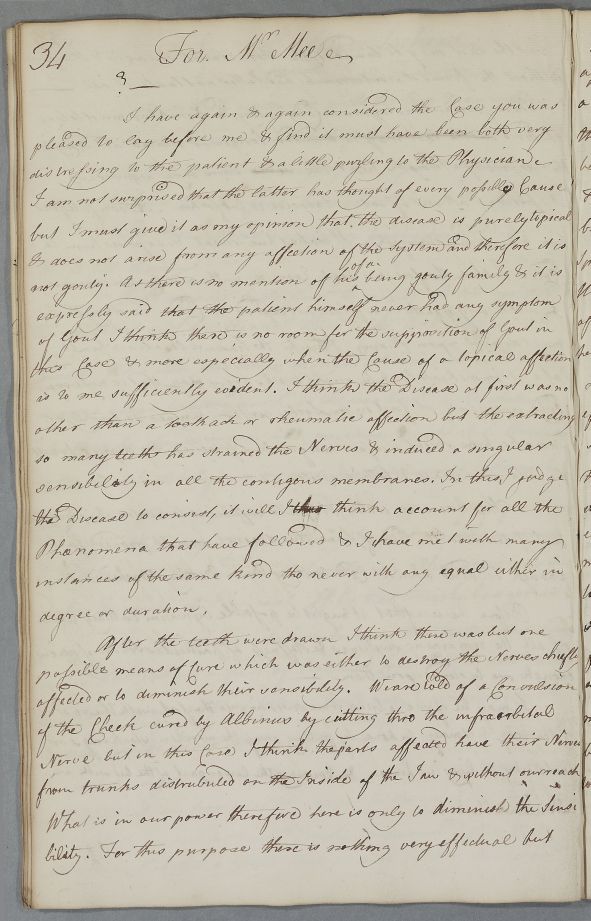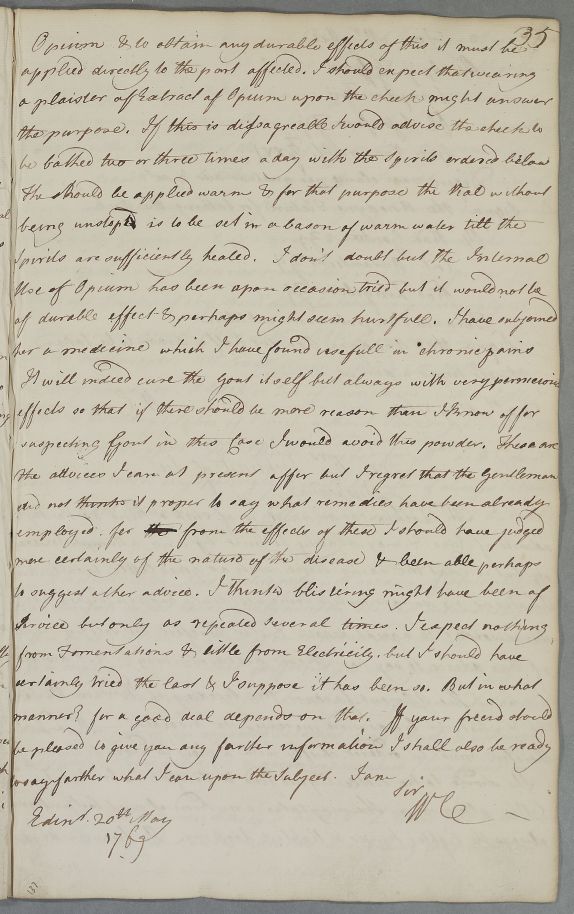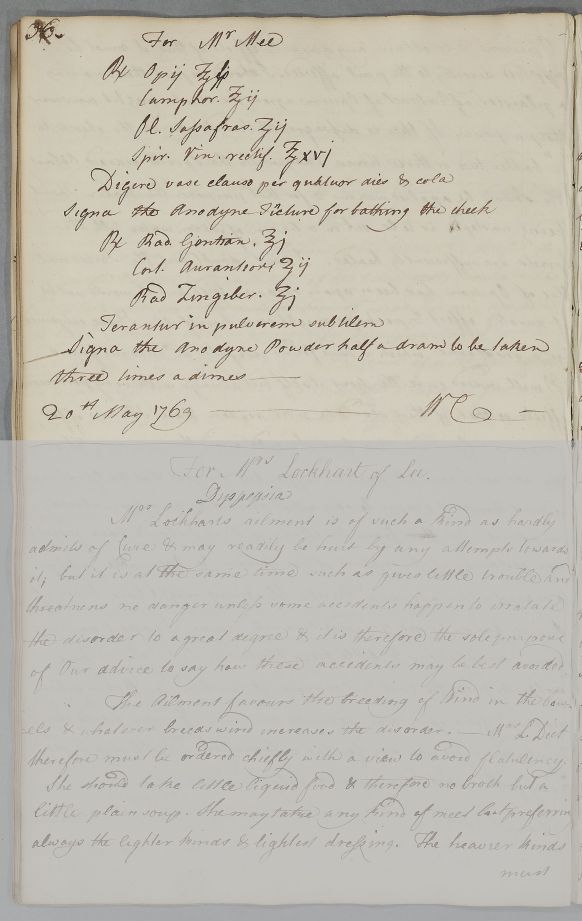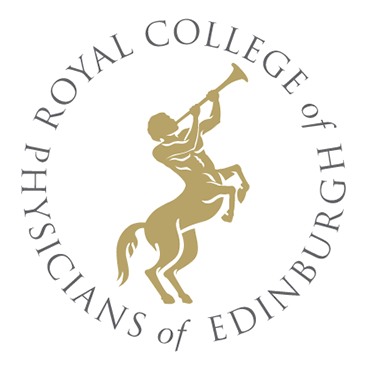
The Consultation Letters of Dr William Cullen (1710-1790) at the Royal College of Physicians of Edinburgh
[ID:57] From: Dr William Cullen (Professor Cullen) / To: Mr Mee / Regarding: Anonymous (Patient) / 20 May 1769 / (Outgoing)
Reply 'For Mr Mee', concerning an unnamed patient whose condition is related to a number of tooth extractions.
- Facsimile
- Normalized Text
- Diplomatic Text
- Metadata
- Case
- People
- Places
Facsimile
There are 3 images for this document.

[Page 1]

[Page 2]

[Page 3]
Metadata
| Field | Data |
|---|---|
| DOC ID | 57 |
| RCPE Catalogue Number | CUL/1/1/1/52 |
| Main Language | English |
| Document Direction | Outgoing |
| Date | 20 May 1769 |
| Annotation | None |
| Type | Scribal copy ( includes Casebook Entry) |
| Enclosure(s) | No enclosure(s) |
| Autopsy | No |
| Recipe | Yes |
| Regimen | No |
| Letter of Introduction | No |
| Case Note | No |
| Summary | Reply 'For Mr Mee', concerning an unnamed patient whose condition is related to a number of tooth extractions. |
| Manuscript Incomplete? | No |
| Evidence of Commercial Posting | No |
Case
Cases that this document belongs to:
| Case ID | Description | Num Docs |
|---|---|---|
| [Case ID:252] |
Case reported by Mr Mee of an unnamed patient whose disorder is related to a number of tooth extractions. |
1 |
People linked to this document
| Person ID | Role in document | Person |
|---|---|---|
| [PERS ID:1] | Author | Dr William Cullen (Professor Cullen) |
| [PERS ID:49] | Addressee | Mr Mee |
| [PERS ID:1000] | Patient | |
| [PERS ID:1] | Patient's Physician / Surgeon / Apothecary | Dr William Cullen (Professor Cullen) |
| [PERS ID:49] | Patient's Relative / Spouse / Friend | Mr Mee |
| [PERS ID:1130] | Other | Bernhard Siegfried Albinus |
Places linked to this document
| Role in document | Specific Place | Settlements / Areas | Region | Country | Global Region | Confidence |
|---|---|---|---|---|---|---|
| Place of Writing | Cullen's House / Mint Close | Edinburgh | Edinburgh and East | Scotland | Europe | certain |
Normalized Text
For Mr Mee
I have again & again considered the Case you was
pleased to lay before me & find it must have been both very
distressing to the patient & a little puzling to the Physician ~
I am not surprised that the latter has thought of every possible cause
but I must give it as my opinion that the disease is purely topical
& does not arise from any affection of the system and therefore it is
not gouty. As there is no mention of his ↑of a↑ being gouty family & it is
expressly said that the patient himself never had any symptom
of Gout I think there is no room for the supposition of Gout in
this case & more especially when the cause of a topical affection
is to me sufficiently evident. I think the Disease at first was no
other than a toothach or rheumatic affection but the extracting
so many teeth has strained the Nerves & induced a singular
sensibility in all the contigous membranes. In this I judge
the Disease to consist, it will I this think account for all the
Phenomena that have followed & I have met with many
instances of the same kind tho never with any equal either in
degree or duration.
After the teeth were drawn I think there was but one
possible means of Cure which was either to destroy the Nerves chiefly
affected or to diminish their sensibility. We are told of a Convulsion
of the Cheek cured by Albinus 1 cutting thro the infraorbital
Nerve but in this case I think the parts affected have their Nerves
from trunks distributed on the Inside of the Jaw & without our reach
What is in our power therefore here is only to diminish the sensi¬
bility. For this purpose there is nothing very effectual but
[Page 2]
Opium & to obtain any durable effects of this it must be
applied directly to the part affected. I should expect that wearing
a plaister of Extract of Opium upon the cheek might answer
the purpose. If this is dissagreeable I would advise the cheek to
be bathed two or three times a day with the spirits ordered below
The should be applied warm & for that purpose the Vial without
being unstoped is to be set in a bason of warm water till the
spirits are sufficiently heated. I don't doubt but the Internal
Use of Opium has been upon occasion tried but it would not be
of durable effect & perhaps might seem hurtfull. I have subjoined
her a medicine which I have found usefull in chronic pains
It will indeed cure the Gout itself but always with very pernicious
effects so that if there should be more reason than I know of for
suspecting Gout in this case I would avoid this powder. These are
the advices I can at present offer but I regret that the Gentleman
did not thinks it proper to say what remedies have been already
employed, for the from the effects of these I should have judged
more certainly of the nature of the disease & been able perhaps
to suggest other advice. I think blistering might have been of
service but only as repeated several times. I expect nothing
from Formentations & little from Electricity. but I should have
certainly tried the last & I suppose it has been so. But in what
manner? for a good deal depends on that. If your friend should
be pleased to give you any farther information I shall also be ready
to say farther what I can upon the subject.
Sir
[Page 3]
For Mr Mee
Take half an ounce of Opium, two ounces of Camphor., two drachms of Sassafras Oil sixteen ounces of Spir. Vin. rectif.. Let it digest in a [clear bottle for four days?] & strain. Label: The Anodyne Tincture for bathing the cheek.
Take one ounce of Gentian. root, two drachms of Orange Peel and one drachm of Ginger root. [Rub the powder {illeg}?]. Label: Anodyne Powder to be taken three times a [day?]
Notes:
1: Bernhard Siegfried Albinus (originally Weiss) (1697–1770), a German-born, Dutch anatomist and author of Tabulae sceleti et musculorum corporis humani (Leiden:1747). Precise reference untraced.
Diplomatic Text
For Mr Mee
I have again & again considered the Case you was
pleased to lay before me & find it must have been both very
distressing to the patient & a little puzling to the Physician ~
I am not surprised that the latter has thought of every possible cause
but I must give it as my opinion that the disease is purely topical
& does not arise from any affection of the system and therefore it is
not gouty. As there is no mention of his ↑of a↑ being gouty family & it is
expressly said that the patient himself never had any symptom
of Gout I think there is no room for the supposition of Gout in
this case & more especially when the cause of a topical affection
is to me sufficiently evident. I think the Disease at first was no
other than a toothach or rheumatic affection but the extracting
so many teeth has strained the Nerves & induced a singular
sensibility in all the contigous membranes. In this I judge
the Disease to consist, it will I this think account for all the
Phenomena that have followed & I have met with many
instances of the same kind tho never with any equal either in
degree or duration.
After the teeth were drawn I think there was but one
possible means of Cure which was either to destroy the Nerves chiefly
affected or to diminish their sensibility. We are told of a Convulsion
of the Cheek cured by Albinus 1 cutting thro the infraorbital
Nerve but in this case I think the parts affected have their Nerves
from trunks distributed on the Inside of the Jaw & without our reach
What is in our power therefore here is only to diminish the sensi¬
bility. For this purpose there is nothing very effectual but
[Page 2]
Opium & to obtain any durable effects of this it must be
applied directly to the part affected. I should expect that wearing
a plaister of Extract of Opium upon the cheek might answer
the purpose. If this is dissagreeable I would advise the cheek to
be bathed two or three times a day with the spirits ordered below
The should be applied warm & for that purpose the Vial without
being unstoped is to be set in a bason of warm water till the
spirits are sufficiently heated. I don't doubt but the Internal
Use of Opium has been upon occasion tried but it would not be
of durable effect & perhaps might seem hurtfull. I have subjoined
her a medicine which I have found usefull in chronic pains
It will indeed cure the Gout itself but always with very pernicious
effects so that if there should be more reason than I know of for
suspecting Gout in this case I would avoid this powder. These are
the advices I can at present offer but I regret that the Gentleman
did not thinks it proper to say what remedies have been already
employed, for the from the effects of these I should have judged
more certainly of the nature of the disease & been able perhaps
to suggest other advice. I think blistering might have been of
service but only as repeated several times. I expect nothing
from Formentations & little from Electricity. but I should have
certainly tried the last & I suppose it has been so. But in what
manner? for a good deal depends on that. If your friend should
be pleased to give you any farther information I shall also be ready
to say farther what I can upon the subject.
Sir
[Page 3]
For Mr Mee
℞ Opij ℥ſs
Camphor. ℥ij
Ol. Sassafras ʒij
Spir. Vin. rectif. ℥xvj
Digere vase [clause per qualuor dies?] & cola
Signa the Anodyne Ti↑n↑cture for bathing the cheek
℞ Rad. Gentian. ℥j
Cort. Aurantiore ʒij
Rad Zingiber ʒj
[Terantur in pulvarem subliem?]
Signa the Anodyne Powder half a dram to be taken
three times a [dimes?]
Notes:
1: Bernhard Siegfried Albinus (originally Weiss) (1697–1770), a German-born, Dutch anatomist and author of Tabulae sceleti et musculorum corporis humani (Leiden:1747). Precise reference untraced.
XML
XML file not yet available.
Feedback
Send us specfic feeback about this document [DOC ID:57]
Please note that the Cullen Project team have now disbanded but your comments will be logged in our system and we will look at them one day...


